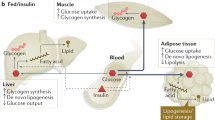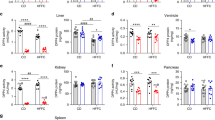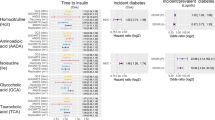Abstract
Insulin resistance is pathogenic for type 2 diabetes and cardiovascular disease. Several inhibitors of insulin signaling have a role in human insulin resistance. The transmembrane glycoprotein ectonucleotide pyrophosphatase phosphodiesterase 1 (E-NPP1; also known as plasma cell membrane glycoprotein PC-1) interacts with the insulin receptor and inhibits subsequent signaling by decreasing its β-subunit autophosphorylation. E-NPP1 is overexpressed in skeletal muscle, adipose tissue and cultured skin fibroblasts of insulin-resistant individuals who are not yet obese or diabetic, which indicates that excessive E-NPP1 expression is an early, intrinsic defect in human insulin resistance. Genetic studies also support a primary role of E-NPP1 in insulin resistance. Among other variants, a missense polymorphism, Lys121Gln, has been described.The Gln121 variant is a stronger inhibitor than Lys121 of insulin receptor function, and is associated with insulin resistance, type 2 diabetes and both cardiovascular and nephrovascular complications in diabetic patients. E-NPP1 is measurable in human serum, where it might represent a valuable biomarker of insulin resistance, but its relationship to tissue and systemic insulin resistance remains to be thoroughly elucidated. Understanding the mechanisms that regulate E-NPP1 expression and/or function might render this protein a new target for strategies to treat and prevent type 2 diabetes and cardiovascular disease.
Key Points
-
Specific inhibitors of insulin receptor signaling have a pathogenic role in insulin resistance, type 2 diabetes and cardiovascular disease
-
Ectonucleotide pyrophosphatase phosphodiesterase 1 (E-NPP1; also known as plasma cell membrane glycoprotein PC-1) interacts with the insulin receptor and inhibits subsequent signaling by decreasing the receptor's β-subunit autophosphorylation
-
The primary, intrinsic role of E-NPP1 in the pathogenesis of in vivo insulin resistance is suggested by its overexpression in skeletal muscle, adipose tissue and cultured skin fibroblasts of nonobese, nondiabetic insulin-resistant individuals
-
Genetic studies have shown that, compared with the common E-NPP1 variant Lys121, the Gln121 variant is a stronger inhibitor of insulin receptor function and is associated with insulin resistance, type 2 diabetes and related cardiovascular and nephrovascular complications
-
Overall, the data published to date on the effect of all known E-NPP1 genetic mutations and risk for type 2 diabetes in more than 19,000 people show quite consistently that E-NPP1 gene variants are associated with type 2 diabetes in several different populations
-
Understanding the mechanisms that regulate E-NPP1 expression and/or function promises to yield important information and new targets to treat or prevent type 2 diabetes and cardiovascular disease
This is a preview of subscription content, access via your institution
Access options
Subscribe to this journal
Receive 12 print issues and online access
$209.00 per year
only $17.42 per issue
Buy this article
- Purchase on Springer Link
- Instant access to full article PDF
Prices may be subject to local taxes which are calculated during checkout


Similar content being viewed by others
References
Reaven GM (1988) Banting lecture 1988. Role of insulin resistance in human disease. Diabetes 37: 1595–1607
Stumvoll M et al. (2005) Type 2 diabetes: principles of pathogenesis and therapy. Lancet 365: 1333–1346
Goding JW et al. (2003) Physiological and pathophysiological functions of the ecto-nucleotide pyrophosphatase/phosphodiesterase family. Biochim Biophys Acta 1638: 1–19
Okawa A et al. (1998) Mutation in Npps in a mouse model of ossification of the posterior longitudinal ligament of the spine. Nat Genet 19: 271–273
Nakamura I et al. (1999) Association of the human NPPS gene with ossification of the posterior longitudinal ligament of the spine (OPLL). Hum Genet 104: 492–497
Johnson K et al. (2003) Linked deficiencies in extracellular PP(i) and osteopontin mediate pathologic calcification associated with defective PC-1 and ANK expression. J Bone Miner Res 18: 994–1004
Rutsch F and Terkeltaub R (2003) Parallels between arterial and cartilage calcification: what understanding artery calcification can teach us about chondrocalcinosis. Curr Opin Rheumatol 15: 302–310
Maddux BA et al. (1995) Membrane glycoprotein PC-1 and insulin resistance in non-insulin-dependent diabetes mellitus. Nature 373: 448–451
Belfiore A et al. (1996) Overexpression of membrane glycoprotein PC-1 in MDA-MB231 breast cancer cells is associated with inhibition of insulin receptor tyrosine kinase activity. Mol Endocrinol 10: 1318–1326
Grupe A et al. (1995) Inhibition of insulin receptor phosphorylation by PC-1 is not mediated by the hydrolysis of adenosine triphosphate or the generation of adenosine. J Biol Chem 270: 22085–22088
Maddux BA and Goldfine ID (2000) Membrane glycoprotein PC-1 inhibition of insulin receptor function occurs via direct interaction with the receptor α-subunit. Diabetes 49: 13–19
Costanzo BV et al. (2001) The Q allele variant (Gln121) of membrane glycoprotein PC-1 interacts with the insulin receptor and inhibits insulin signaling more effectively than the common K allele variant (Lys121). Diabetes 50: 831–836
Sakoda H et al. (1999) No correlation of plasma cell 1 overexpression with insulin resistance in diabetic rats and 3T3-L1 adipocytes. Diabetes 48: 1365–1371
Gijsbers R et al. (2003) Functional characterization of the non-catalytic ectodomains of the nucleotide pyrophosphatase/phosphodiesterase NPP1. Biochem J 371: 321–330
Menzaghi C et al. (2003) Insulin modulates PC-1 processing and recruitment in cultured human cells. Am J Physiol Endocrinol Metab 284: E514–E520
Dong H et al. (2005) Increased hepatic levels of the insulin receptor inhibitor, PC-1/NPP1, induce insulin resistance and glucose intolerance. Diabetes 54: 367–372
Maddux BA et al. (2006) Overexpression of the insulin receptor inhibitor, PC-1/ENPP1, induces insulin resistance and hyperglycemia. Am J Physiol Endocrinol Metab 290: E746—E749
Frittitta L et al. (1996) PC-1 content in skeletal muscle of non-obese, non-diabetic subjects: relationship to insulin receptor tyrosine kinase and whole body insulin sensitivity. Diabetologia 39: 1190–1195
Youngren JF et al. (1996) Skeletal muscle content of membrane glycoprotein PC-1 in obesity. Relationship to muscle glucose transport. Diabetes 45: 1324–1328
Shao J et al. (2000) Decreased insulin receptor tyrosine kinase activity and plasma cell membrane glycoprotein-1 overexpression in skeletal muscle from obese women with gestational diabetes mellitus (GDM): evidence for increased serine/threonine phosphorylation in pregnancy and GDM. Diabetes 49: 603–610
Frittitta L et al. (1997) Increased adipose tissue PC-1 protein content, but not tumour necrosis factor-α gene expression, is associated with a reduction of both whole body insulin sensitivity and insulin receptor tyrosine-kinase activity. Diabetologia 40: 282–289
Tomazic M et al. (2002) Comparison of alterations in insulin signalling pathway in adipocytes from type II diabetic pregnant women and women with gestational diabetes mellitus. Diabetologia 45: 502–508
Teno S et al. (1999) Increased activity of membrane glycoprotein PC-1 in the fibroblasts from non-insulin-dependent diabetes mellitus patients with insulin resistance. Diabetes Res Clin Pract 45: 25–30
Frittitta L et al. (1998) Elevated PC-1 content in cultured skin fibroblasts correlates with decreased in vivo and in vitro insulin action in nondiabetic subjects: evidence that PC-1 may be an intrinsic factor in impaired insulin receptor signaling. Diabetes 47: 1095–1100
Atwood LD et al. (2002) Genomewide linkage analysis of body mass index across 28 years of the Framingham Heart Study. Am J Hum Genet 71: 1044–1050
Duggirala R et al. (2001) A major locus for fasting insulin concentrations and insulin resistance on chromosome 6q with strong pleiotropic effects on obesity-related phenotypes in nondiabetic Mexican Americans. Am J Hum Genet 68: 1149–1164
Meyre D et al. (2004) A genome-wide scan for childhood obesity-associated traits in French families shows significant linkage on chromosome 6q22.31–q23.2. Diabetes 53: 803–811
Meyre D et al. (2005) Variants of ENPP1 are associated with childhood and adult obesity and increase the risk of glucose intolerance and type 2 diabetes. Nat Genet 37: 863–867
Ghosh S et al. (2000) The Finland-United States investigation of non-insulin-dependent diabetes mellitus genetics (FUSION) study. I. An autosomal genome scan for genes that predispose to type 2 diabetes. Am J Hum Genet 67: 1174–1185
Demenais F et al. (2003) A meta-analysis of four European genome screens (GIFT Consortium) shows evidence for a novel region on chromosome 17p11.2–q22 linked to type 2 diabetes. Hum Mol Genet 12: 1865–1873
Xiang K et al. (2004) Genome-wide search for type 2 diabetes/impaired glucose homeostasis susceptibility genes in the Chinese: significant linkage to chromosome 6q21–q23 and chromosome 1q21–q24. Diabetes 53: 228–234
Pizzuti A et al. (1999) A polymorphism (K121Q) of the human glycoprotein PC-1 gene coding region is strongly associated with insulin resistance. Diabetes 48: 1881–1884
Gu HF et al. (2000) Association between the human glycoprotein PC-1 gene and elevated glucose and insulin levels in a paired-sibling analysis. Diabetes 49: 1601–1603
Frittitta L et al. (2001) The Q121 PC-1 variant and obesity have additive and independent effects in causing insulin resistance. J Clin Endocrinol Metab 86: 5888–5891
Kubaszek A et al. (2003) The K121Q polymorphism of the PC-1 gene is associated with insulin resistance but not with dyslipidemia. Diabetes Care 26: 464–467
Abate N et al. (2003) Genetic polymorphism PC-1 K121 Q and ethnic susceptibility to insulin resistance. J Clin Endocrinol Metab 88: 5927–5934
Kubaszek A et al. (2004) The association of the K121Q polymorphism of the plasma cell glycoprotein-1 gene with type 2 diabetes and hypertension depends on size at birth. J Clin Endocrinol Metab 89: 2044–2047
Hamaguchi K et al. (2004) The PC-1 Q121 allele is exceptionally prevalent in the Dominican Republic and is associated with type 2 diabetes. J Clin Endocrinol Metab 89: 1359–1364
Abate N et al. (2005) ENPP1/PC-1 K121Q polymorphism and genetic susceptibility to type 2 diabetes. Diabetes 54: 1207–1213
Bacci S et al. (2005) The K121Q polymorphism of the ENPP1/PC-1 gene is associated with insulin resistance/atherogenic phenotypes, including earlier onset of type 2 diabetes and myocardial infarction. Diabetes 54: 3021–3025
Barroso I et al. (2003) Candidate gene association study in type 2 diabetes indicates a role for genes involved in β-cell function as well as insulin action. PLoS Biol 1: E20
Bochenski J et al. (2006) New polymorphism of ENPP1 (PC-1) is associated with increased risk of type 2 diabetes among obese individuals. Diabetes 55: 2626–2630
Rasmussen SK et al. (2000) The K121Q variant of the human PC-1 gene is not associated with insulin resistance or type 2 diabetes among Danish Caucasians. Diabetes 49: 1608–1611
Keshavarz P et al. (2006) No evidence for association of the ENPP1 (PC-1) K121Q variant with risk of type 2 diabetes in a Japanese population. J Hum Genet 51: 559–566
Grarup N et al. (2006) Studies of the relationship between the ENPP1 K121Q polymorphism and type 2 diabetes, insulin resistance and obesity in 7,333 Danish white subjects. Diabetologia 49: 2097–2104
Frittitta L et al. (2001) A cluster of three single nucleotide polymorphisms in the 3'-untranslated region of human glycoprotein PC-1 gene stabilizes PC-1 mRNA and is associated with increased PC-1 protein content and insulin resistance-related abnormalities. Diabetes 50: 1952–1955
Endler G et al. (2002) The K121Q polymorphism in the plasma cell membrane glycoprotein 1 gene predisposes to early myocardial infarction. J Mol Med 80: 791–795
De Cosmo S et al. (2000) A PC-1 amino acid variant (K121Q) is associated with faster progression of renal disease in patients with type 1 diabetes and albuminuria. Diabetes 49: 521–524
Canani LH et al. (2002) Polymorphism in ecto-nucleotide pyrophosphatase/phosphodiesterase 1 gene (ENPP1/PC-1) and early development of advanced diabetic nephropathy in type 1 diabetes. Diabetes 51: 1188–1193
De Cosmo S et al. (2003) PC-1 amino acid variant Q121 is associated with a lower glomerular filtration rate in type 2 diabetic patients with abnormal albumin excretion rates. Diabetes Care 26: 2898–2902
Matsuoka N et al. (2006) Association of K121Q polymorphism in ENPP1 (PC-1) with BMI in Caucasian and African-American adults. Int J Obes (Lond) 30: 233–237
Prudente S et al. The Q121/Q121 genotype of ENPP1/PC-1 is associated with lower BMI in non-diabetic Caucasians. Obesity, in press
Bruning JC et al. (2000) Role of brain insulin receptor in control of body weight and reproduction. Science 289: 2122–2125
Swinburn BA et al. (1991) Insulin resistance associated with lower rates of weight gain in Pima Indians. J Clin Invest 88: 168–173
Frittitta L et al. (1999) A soluble PC-1 circulates in human plasma: relationship with insulin resistance and associated abnormalities. J Clin Endocrinol Metab 84: 3620–3625
Stefanovic V et al. (1999) Reversal of increased lymphocyte PC-1 activity in patients with type 2 diabetes treated with metformin. Diabetes Metab Res Rev 15: 400–404
Di Paola R et al. (2002) A variation in 3' UTR of hPTP1B increases specific gene expression and associates with insulin resistance. Am J Hum Genet 70: 806–812
Bento JL et al. (2004) Association of protein tyrosine phosphatase 1B gene polymorphisms with type 2 diabetes. Diabetes 53: 3007–3012
Palmer ND et al. (2004) Association of protein tyrosine phosphatase 1B gene polymorphisms with measures of glucose homeostasis in Hispanic Americans: the insulin resistance atherosclerosis study (IRAS) family study. Diabetes 53: 3013–3019
Spencer-Jones NJ et al. (2005) Protein tyrosine phosphatase-1B gene PTPN1: selection of tagging single nucleotide polymorphisms and association with body fat, insulin sensitivity, and the metabolic syndrome in a normal female population. Diabetes 54: 3296–3304
Weedon MN et al. (2006) No evidence of association of ENPP1 variants with type 2 diabetes or obesity in a study of 8,089 U.K. Caucasians. Diabetes 55: 3175–3179
Lyon HN et al. (2006) Common variants in the ENPP1 gene are not reproducibly associated with diabetes or obesity. Diabetes 55: 3180–3184
Acknowledgements
V Trischitta is supported by Telethon grant E1239, and R Di Paola is supported by Telethon grant GGP02423, and Ministry of University and Scientific Research grant FIRB RBNE01N4Z9_009, N Abate is supported by NIH grants K23-RR16075 and RO1 DK072158-01, and M Chandalia is supported by CDC grants H75/CCH523202 and AHA 0465017Y.
Author information
Authors and Affiliations
Corresponding authors
Ethics declarations
Competing interests
The authors declare no competing financial interests.
Rights and permissions
About this article
Cite this article
Abate, N., Chandalia, M., Di Paola, R. et al. Mechanisms of Disease: ectonucleotide pyrophosphatase phosphodiesterase 1 as a 'gatekeeper' of insulin receptors. Nat Rev Endocrinol 2, 694–701 (2006). https://doi.org/10.1038/ncpendmet0367
Received:
Accepted:
Issue Date:
DOI: https://doi.org/10.1038/ncpendmet0367
This article is cited by
-
Hyperuricemia-induced endothelial insulin resistance: the nitric oxide connection
Pflügers Archiv - European Journal of Physiology (2022)
-
A review on interplay between obesity, lipoprotein profile and nutrigenetics with selected candidate marker genes of type 2 diabetes mellitus
Molecular Biology Reports (2022)
-
Enzymology of extracellular NAD metabolism
Cellular and Molecular Life Sciences (2021)
-
GALNT2 as a novel modulator of adipogenesis and adipocyte insulin signaling
International Journal of Obesity (2019)
-
Cellular function and molecular structure of ecto-nucleotidases
Purinergic Signalling (2012)



